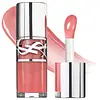What's inside
What's inside
 Key Ingredients
Key Ingredients

 Benefits
Benefits

 Concerns
Concerns

 Ingredients Side-by-side
Ingredients Side-by-side

Squalane
EmollientSimmondsia Chinensis Seed Oil
EmollientPentaerythrityl Tetraisostearate
EmollientEthylene/Propylene/Styrene Copolymer
Bis-Behenyl/Isostearyl/Phytosteryl Dimer Dilinoleyl Dimer Dilinoleate
EmollientCorylus Avellana Seed Oil
EmollientSilica Silylate
EmollientDiisostearyl Malate
EmollientParfum
MaskingRosa Rubiginosa Seed Oil
EmollientTocopheryl Acetate
AntioxidantButylene/Ethylene/Styrene Copolymer
CI 45410
Cosmetic ColorantVanillin
MaskingPentaerythrityl Tetra-Di-T-Butyl Hydroxyhydrocinnamate
AntioxidantCI 77891
Cosmetic ColorantAlumina
AbrasiveGlycerin
HumectantSqualane, Simmondsia Chinensis Seed Oil, Pentaerythrityl Tetraisostearate, Ethylene/Propylene/Styrene Copolymer, Bis-Behenyl/Isostearyl/Phytosteryl Dimer Dilinoleyl Dimer Dilinoleate, Corylus Avellana Seed Oil, Silica Silylate, Diisostearyl Malate, Parfum, Rosa Rubiginosa Seed Oil, Tocopheryl Acetate, Butylene/Ethylene/Styrene Copolymer, CI 45410, Vanillin, Pentaerythrityl Tetra-Di-T-Butyl Hydroxyhydrocinnamate, CI 77891, Alumina, Glycerin
Polybutene
Hydrogenated Polyisobutene
EmollientDiisostearyl Malate
EmollientTridecyl Trimellitate
EmollientOctyldodecanol
EmollientSilica Dimethyl Silylate
EmollientCalcium Sodium Borosilicate
Sorbitan Isostearate
EmulsifyingGlyceryl Caprylate
EmollientCI 77891
Cosmetic ColorantParfum
MaskingMethyl Nicotinate
SoothingTocopheryl Acetate
AntioxidantDehydroacetic Acid
PreservativePolyglyceryl-2 Triisostearate
EmulsifyingZingiber Officinale Root Oil
MaskingCanola Oil
EmollientCapsicum Frutescens Fruit Extract
Skin ConditioningCI 77499
Cosmetic ColorantCI 17200
Cosmetic ColorantCaprylic/Capric Triglyceride
MaskingCI 42090
Cosmetic ColorantTin Oxide
AbrasiveCI 45410
Cosmetic ColorantPolyglyceryl-2 Diisostearate
EmulsifyingHyaluronic Acid
HumectantPanthenol
Skin ConditioningFicus Carica Fruit Extract
HumectantPolybutene, Hydrogenated Polyisobutene, Diisostearyl Malate, Tridecyl Trimellitate, Octyldodecanol, Silica Dimethyl Silylate, Calcium Sodium Borosilicate, Sorbitan Isostearate, Glyceryl Caprylate, CI 77891, Parfum, Methyl Nicotinate, Tocopheryl Acetate, Dehydroacetic Acid, Polyglyceryl-2 Triisostearate, Zingiber Officinale Root Oil, Canola Oil, Capsicum Frutescens Fruit Extract, CI 77499, CI 17200, Caprylic/Capric Triglyceride, CI 42090, Tin Oxide, CI 45410, Polyglyceryl-2 Diisostearate, Hyaluronic Acid, Panthenol, Ficus Carica Fruit Extract
Ingredients Explained
These ingredients are found in both products.
Ingredients higher up in an ingredient list are typically present in a larger amount.
CI 45410 is a synthetic red-pigment and dye.
It often goes by both Red 28 or Red 27; manufacturers label both ingredients as CI 45410.
This dye is commonly found in makeup because it imparts a vivid color. Some types of this dye change color based on pH level and interaction with moisture:
Your skin has a natural pH of around 4.5 - 5.5.
According to the FDA, CI 45410 is not permitted for use in eye products.
Red 27 is a flourescein dye and commonly used as a fluorescent tracer in medicine.
Learn more about CI 45410Ci 77891 is a white pigment from Titanium dioxide. It is naturally found in minerals such as rutile and ilmenite.
It's main function is to add a white color to cosmetics. It can also be mixed with other colors to create different shades.
Ci 77891 is commonly found in sunscreens due to its ability to block UV rays.
Learn more about CI 77891Diisostearyl Malate is an emollient and most often used in lip products. It comes from isostearyl alcohol, a fatty acid, and malic acid, an AHA.
As an emollient, Diisostearyl Malate helps create a thin film on your skin to trap moisture in. This helps keep your skin soft and smooth.
Parfum is a catch-all term for an ingredient or more that is used to give a scent to products.
Also called "fragrance", this ingredient can be a blend of hundreds of chemicals or plant oils. This means every product with "fragrance" or "parfum" in the ingredients list is a different mixture.
For instance, Habanolide is a proprietary trade name for a specific aroma chemical. When used as a fragrance ingredient in cosmetics, most aroma chemicals fall under the broad labeling category of “FRAGRANCE” or “PARFUM” according to EU and US regulations.
The term 'parfum' or 'fragrance' is not regulated in many countries. In many cases, it is up to the brand to define this term.
For instance, many brands choose to label themselves as "fragrance-free" because they are not using synthetic fragrances. However, their products may still contain ingredients such as essential oils that are considered a fragrance by INCI standards.
One example is Calendula flower extract. Calendula is an essential oil that still imparts a scent or 'fragrance'.
Depending on the blend, the ingredients in the mixture can cause allergies and sensitivities on the skin. Some ingredients that are known EU allergens include linalool and citronellol.
Parfum can also be used to mask or cover an unpleasant scent.
The bottom line is: not all fragrances/parfum/ingredients are created equally. If you are worried about fragrances, we recommend taking a closer look at an ingredient. And of course, we always recommend speaking with a professional.
Learn more about ParfumTocopheryl Acetate is AKA Vitamin E. It is an antioxidant and protects your skin from free radicals. Free radicals damage the skin by breaking down collagen.
One study found using Tocopheryl Acetate with Vitamin C decreased the number of sunburned cells.
Tocopheryl Acetate is commonly found in both skincare and dietary supplements.
Learn more about Tocopheryl Acetate